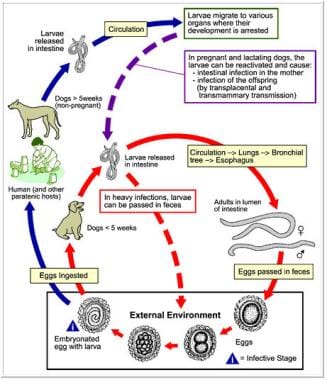Practice Essentials
Several roundworm parasites found in domestic animals can infect humans. Parasites are usually found in the larval stages in human tissues and provoke the clinical condition referred to as larva migrans. Toxocara species, the ascarid of dogs and cats, is most commonly associated with larva migrans. Classic visceral larva migrans (VLM) typically occurs in preschool-aged children with a history of eating dirt. [1] Children can present with severe infection and can suffer from seizures, myocarditis, and encephalitis. Death has also been reported in some cases. [2]
Signs and symptoms
Children with visceral larva migrans may complain of loss of appetite, fever, cough, wheezing, or abdominal pain.
Children may have marked hepatomegaly and splenomegaly, wheezing, and rales. Children may also have a pruritic rash or urticaria.
See Presentation for more detail.
Diagnosis
Laboratory studies
A complete blood cell (CBC) count often reveals leukocytosis and eosinophilia; however, eosinophilia may not always be present. Children may be anemic.
Obtain stool cultures to rule out other parasitic infections.
Imaging studies
Children may exhibit an abnormal liver parenchymal pattern on both abdominal ultrasonography and computed tomography (CT) scanning.
Magnetic resonance imaging (MRI) may reveal multiple cerebral lesions in patients with central nervous system (CNS) visceral larva migrans.
Pulmonary infiltrates due to visceral larva migrans generally manifest as a transient form of Löffler syndrome or simple eosinophilic pneumonia on a chest radiograph.
See Workup for more detail.
Management
Therapy for patients with visceral larva migrans is aimed at relieving symptoms and is intended to diminish the host inflammatory response to the parasite.
See Treatment and Medication for more detail.
Pathophysiology
Children contract Toxocara infections by ingesting embryonated eggs. The larvae hatch in the small intestine, invade the mucosa, and enter the portal system. The liver traps some larvae, but other larvae proceed to the lungs and the circulatory system, where they can disseminate to virtually every organ. In particular, the larvae often deposit in the liver, lungs, eye, heart, and brain. However, the parasite cannot complete its life cycle in humans. Larvae persist in tissues, provoking a granulomatous reaction and eventually dying. As a result, abscesses or granulomas form. Clinical manifestations depend on the tissue damage caused by the invading larvae and the associated immune-mediated inflammatory response.
See the image below.
Etiology
Toxocara canis is the most common cause of visceral larva migrans. Mature T canis worms live in the small intestines of dogs, their natural host. Heavily infected dogs can pass millions of eggs each day in their feces. [3] A meta-analysis by Bonilla-Aldana et al showed that the pooled prevalence of T canis eggs in public parks in Latin America is 50%. [4]
Toxocara cati can also cause visceral larva migrans.
Other etiologic agents include Baylisascaris procyonis, Capillaria hepatica, Ascaris suum, and some Ancylostoma species.
Epidemiology
United States statistics
The seroprevalence of Toxocara infection in children varies from 2-10%.
International statistics
Although most reported cases occur in the United States, international incidence is likely similar or slightly higher. In Turkey, reported rates of Toxocara seropositivity range between 1% and 56%. [5]
Race-, sex-, and age-related demographics
Race
Infection rates are higher among Blacks and Hispanics, likely because of greater exposure to the parasite.
Sex
Visceral larva migrans has no sex predilection.
Age
Infection primarily occurs in children aged 1-4 years but can occur at any age.
Prognosis
Visceral larva migrans is generally benign and self-limiting. However, serious sequelae can occur, resulting in significant risk of morbidity and mortality.
Morbidity/mortality
Death is rare. Long-term morbidity is present with ocular larva migrans (ie, loss of vision in the affected eye) but not usually with visceral larva migrans. Chronic eosinophilic pneumonia, myocarditis, and Henoch-Schönlein purpura have been associated with visceral larva migrans.
Wygant and Cohle reported a fatal case of visceral larva migrans from T catis infection of the heart and liver in a 19-month-old child. [2]
Complications
Complications include the following:
-
Seizures
-
Myocarditis
-
Encephalitis
-
Abscess
-
Decreased visual acuity and blindness
-
Death
Patient Education
Instruct caregiver to worm household pets and to properly dispose of pet feces.
Encourage good personal hygiene, including washing hands after playing with pets.
Encourage caregivers to prevent children from playing in areas that are soiled with pet or other animal feces.
Teach older children that eating dirt may be dangerous.
-
Diagram of the Toxocara canis life cycle image. Courtesy of the Centers for Disease Control and Prevention.




